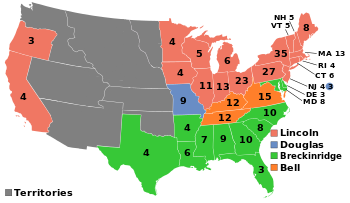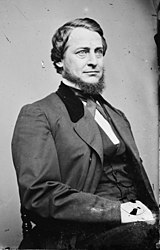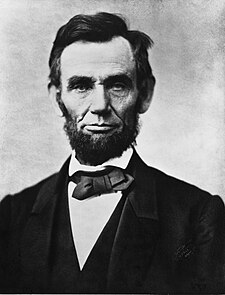The Lead Up and the War
Of course, tensions between the North and South had been brewing just under the surface since America declared its Independence from Britain. Free States vs. Slave states, Industry vs. Agriculture, Urban vs. Rural. Many believe that the conflict between the regions was inevitable. It would be the election of 1860 that brought the tensions to ahead, and led to the eruption of war. The Democratic Party had splintered into 2, the Northerners nominating Stephen Douglas, and the Southerners nominating Vice President John Breckinridge. Despite the efforts of the Whig Candidate, Lincoln would win the electoral vote and become President with 39.8% of the vote. It should be noted, that had the 60% of the country that didn’t vote for Lincoln, voted for one candidate, Lincoln would have won the electoral college with 169 electoral votes, having lost California, Oregon and New Jersey.
Presidential election results map.
Red denotes states won by Lincoln/Hamlin,
spring green denotes those won by Breckinridge/Lane,
orange denotes those won by Bell/Everett, and
blue denotes those won by Douglas/Johnson. Numbers indicate the number of electoral votes allotted to each state.
Ticket Popular Vote/Percentage Electoral Vote
Lincoln/Hamlin: 1,865,908 39.8% 180
Breckinridge/Lane: 848,019 18.1% 72
Bell/Everrett: 590,901 12.6% 39
Douglas/Johnson 1,380,202 29.5% 12
Very quickly, states began seceding from the Union, at first it was South Carolina, Mississippi, Florida, Alabama, Georgia, Louisiana, and Texas who seceded before February of 1861. These states formed a Constitutional Convention in February, borrowing most of the US Constitution, while explicitly protecting slavery and providing the President with a line item veto, and gave more power to the states. Also important, the President had a 6 year term, with no chance of re-election. This Convention Appointed Jefferson Davis of Mississippi to be President, and Alexander Stephenson of Georgia to be Vice President. Despite the explicit 6 year term, the Convention allowed leeway for Davis and Stephenson, allowing them to be elected proper in November of 1861. Davis would be inaugurated on February 18th, 1861. He would quickly establish ties with Britain and France, in an attempt to bring them to recognize the Confederacy. Meanwhile, President Buchanan stood by, providing little resistance to the newly formed Confederacy.
Politically, the two major Parties that formed in the Confederacy were the Democrats and the Whigs. The Democrats, led by President Davis held a strong majority in the newly formed Congress. Only the wealthy were allowed to vote in the Confederacy.
The War of Secession (1861-1862)
Lincoln was inaugurated on March 4th, 1861. He quickly began manipulating the Confederacy into starting the war, sending supplies to bases in the South. On April 12, Confederates fired on Fort Sumter, and Lincoln called for troops 3 days later, the war having begun. This lead to Virginia, Arkansas, Tennessee, and North Carolina seceding. By July 4th, West Virginia had separated itself from Virginia, Southern Missouri had joined the South, Sequoyah’s government(at the time it was known as Oklahoma or “The Indian Territories”) joined the South, while 2/3 remained in Union hands, and Southern Arizona joined the Confederacy. Kentucky was preparing to secede, before being stopped by the Union.
July 4th would be an important day for the Confederacy. President Davis vetoed legislation that would keep cotton from being shipped overseas, declaring the need for cooperation with European powers. Also, Davis signed a law calling for the training of 4 divisions to be ready by September 13th. Also, 40 thousand men that had volunteered in the beginning of the war were ready to reinforce the divisions already raised. On the domestic front, Davis raised taxes on everyone to 50%, raised tariffs to 25% and passed wide reaching Education initiatives, and comprehensive law enforcement. He put signed into law legislation to keep the army and navy well maintained, and to improve recruiting efforts. The military spending would have to be reauthorized on the first of every year or cut to the bare minimum. General Johnston was put in charge of 3 divisions, with the intent of exploiting the Union’s weakness in Missouri, and Robert E. Lee was placed in charge of the Army of Northern Virginia, 70 thousand men strong, which would be ready in Fredericksburg. The plan, as laid out by Davis, Lee and Johnston, would be to draw Union forces to Missouri, and away from Washington D.C. Lee would strike up and capture D.C., then move onto Philadelphia, the planned emergency capital of the Union. Having captured both capitals, the Confederacy would ask France and Britain to negotiate a peace between the two powers. Incorporation of Border States would then be decided there. This had to be accomplished quickly, because in the long run, with the Union’s industrial superiority and larger numbers, the Union would eventually overwhelm the Confederacy. This plan went almost flawlessly.
Lincoln wanted Lee to head up the Union Army, to bring the Confederacy to its knees. When Virginia seceded, Lee went with it, so that responsibility fell on General George B McClellan. McClellan’s failings, when compared with Robert E. Lee’s strengths, would prove to be the edge the Confederacy needed. McClellan was a very passive General, whose strategy consisted mostly of defending Union territory, while only mounting minor skirmishes into the Confederacy, much to the annoyance of President Lincoln.
The Army of Northern Virginia would rally in Fredericksburg on July 16th, Lee would march them to Staunton to protect the steel mill there. Lee wanted to move into D.C. right away, but needed to protect the heart of the Confederate industry, and Lynchburg, so that the Federals couldn’t cut into Richmond. Also, McClellan had too many forces in D.C. to launch the invasion. Johnston would personally lead the 10K men to Jefferson City, Missouri, while Major General Cheatham would take 20K men to Rolla.

On July 25th, Union soldiers, led by Lt. Blodgett met with 12K of Johnston’s men, lead by Cheatham, who were supported by artillery in Rolla, Missouri. Three days later, 10K reinforcements would join the battle. On July 29th, the Confederate forces won the battle, the US lost 830 men, and the Confederates had lost 410 men. This first battle, the Battle of Rolla, would be a Confederate victory. Johnston’s men were reinforced by Missouri volunteers, and then pressed their advantage by advancing to St. Louis. On July 30th, Manassas fell to McClellan’s army.
On August 4th, 72K of Lee’s men met 10K men, lead by Lt. White, that were moving to capture Staunton. After 2 days of fighting, the Battle of Staunton was a Confederate victory. 900 Union soldiers died, 210 Confederates died. Lee quickly ordered Major General Stuart’s 10K cavalry to hold Lynchburg until the conscripted divisions were ready to take over. Lee started marching the army of Northern Virginia, 52K men, back to Fredericksburg, while Lt. General Jackson and 10K men were ordered to hold Staunton. Meanwhile the Union had 86 Men in Manassas, and was further fortifying West Virginia. The survivors from Rolla had made it to St. Louis. Right around August 9th, Davis refused an offer from the Governor of Nueva Leon for the annexation of his territory, Davis didn’t want a war with Mexico. August 10th was the beginning of the Battle of St. Louis, Major General Cheatham had once again engaged Blodgett’s forces. The battle ended on August 15th, another victory for the Confederacy. The Union lost another 740 men, bring it to 8340, and the Confederates had lost 610 men. Blodgett’s forces, overwhelmed retreated to Cairo, Illinois while, Cheatham continued marching to Rolla. On August 18th, 12K men lead by Lt. White engaged Jackson at Stauton, the same day that Lee’s army arrived in Fredricksburg. Lee stayed at the ready in the event that Jackson needed support. On August 20, Jackson’s men repelled White’s men. White suffered 240 casualties, Jackson only 100. The Second Battle for Staunton earned Jackson his nickname, “Stonewall.” Reinforcements were quickly sent to replace those killed.
September began with little movement from the Confederates. Lee was waiting for the soldiers promised him by Jefferson Davis. On September 7th, the Unionists in the state government fled from Jefferson City to Kansas City. The next day, Johnston took the city, he resupplied, and on the 11th, he left for Kansas City. On September 14th, those first 4 divisions were ready, 1 division was sent to Lynchburg, so that JEB Stuart could join Lee at Fredericksburg, the other 3 would be immediately dispatched to Lee, who would wait for Stuart before marching to Manassas. Johnston wrote to Davis asking for reinforcements, believing that he could bring Missouri into the Confederacy, with enough troops. This was a secondary objective for the Confederacy, so Davis promised that Johnston would get 10K men would join him in Missouri on November 5th. A delay in communication led to Stuart not leaving for Fredericksburg until September 16th. Johnston’s troops ended up outside Kansas City on September 19th. On September 21st, St. Louis fell to the Confederates, where Missouri volunteers filled in as reinforcements. Lt. Hindman would guard the city, while Cheatham would march to meet Johnston. At this time, 90K men, lead my McClellan guarded D.C. 52K men held Manassas, and 80K held West Virginia. At this time, the whole Confederate army was about 140K men, a little less than half the size of the Union forces. On September 26th, Stuart arrived in Fredericksburg, so Lee and his 92K men marched to Manassas. The confrontation there would prove to be the first blood bath of the war.
On October 1st, Lt. White attacked Cheatham’s position in St. Louis. Cheatham and his artillery turned back to St. Louis to hit the Union forces. After 2 days of fighting, the Second Battle of St. Louis was won by the Confederates. The Union lost 920 men, the Confederacy had lost 870. Cheatham would meet up with Johnston’s forces the next day, October 4th. On October 7th, Lee’s 92K met an army of 82K, led by General McClellan. Lee had been expecting a lighter force, and was dismayed to see so many Union soldiers. Word was quickly sent to Davis to get reinforcements ready. On October 16th, Lt. Higgenbotham attacked St. Louis. On October 20th, the Unionist legislators in Missouri fled to Iowa, and the next day Kansas city fell to Johnston. Johnston marched to St. Louis to help Hindham hold his position. On October 25th, more Union forces joined Higgenbotham in St. Louis.
On November 2nd, 50K men, led by General Meade attacked Jackson’s position in Stauton. On November 5th, the forces promised to Johnston were sent to Fredricksburg instead, they marched to Manassas to help Lee. On November 6th, Davis was elected to a full term as Confederate President with every state backing him for President, he was after all, unopposed. At the same time, Democrats won 60% of the House and Senate, actually losing ground to the Whig Party. If Stonewall could hold a little while longer, Lee could move from Manassas and help him. On November 14th, Johnston arrived in St Louis, and the new division arrived in Manassas the next day. So far, each side had taken almost 50% casualties at Manassas. Hindman’s division had taken 50% casualties, but Johnston’s efforts saved the day on November 16th. Reinforcements were immediately sent. Cheatham was sent back to Kansas City, Johnston moved on to Rolla. On November 21st, the first national flag of the Confederacy was selected.

On November 28th, Cheatham engaged 10K cavalry in Kansas City.
On December 5th, Johnston attacked the forces in Rolla. On December 9th, the Battle of Manassas was over, the Union only had 14K of their original 82K, and Lee only had 33K of their original 120K. It was a horrible and bloody victory for the Confederacy. Lee just had to get to Manassas, and then he could help Jackson. On December 24th, Manassas fell to Lee; where he was rewarded with over 70K reinforcements. He left Longstreet to defend Manassas, and marched to back up Jackson. But, by December 28th, it was becoming clear that Johnston was losing the Battle of Rolla, so Hindman marched to Rolla, while at the same time, reinforcements arrived in Kansas City to attack Cheatham. The year drew to a close with the Confederacy in a very strong position.






















